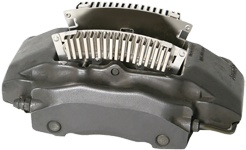Lower the temperature of your brake calipers over 20%
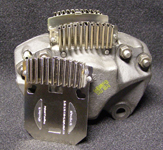 Four Products LLC has developed an innovative solution to reduce or eliminate the effects of brake fade.
The Patented CoolShim brake cooler (once known as the Fade Stop Brake Cooler or FSBC) is a brake accessory that is mounted between the brake pad and the caliper piston.
The CoolShim is a “drop-in” part that is as easy to install as a new set of brake pads.
It conducts heat from the caliper piston to a heat sink located externally to the brake caliper through a high thermal conductivity dual metal composite developed by Four Products specifically for the extreme thermal conditions found in a high performance brake system.
Testing has revealed a greater than 20% decrease in maximum caliper piston temperature as well as significantly faster cool down times for a caliper employing CoolShim technology.
Four Products LLC has developed an innovative solution to reduce or eliminate the effects of brake fade.
The Patented CoolShim brake cooler (once known as the Fade Stop Brake Cooler or FSBC) is a brake accessory that is mounted between the brake pad and the caliper piston.
The CoolShim is a “drop-in” part that is as easy to install as a new set of brake pads.
It conducts heat from the caliper piston to a heat sink located externally to the brake caliper through a high thermal conductivity dual metal composite developed by Four Products specifically for the extreme thermal conditions found in a high performance brake system.
Testing has revealed a greater than 20% decrease in maximum caliper piston temperature as well as significantly faster cool down times for a caliper employing CoolShim technology.
An Introduction to Brake Fade and Failure
In a typical disk brake system a caliper holds a pair of hydraulically actuated pistons which force a pair of pads into contact with the spinning rotor. The pads have a high coefficient of friction and when they are clamped onto the spinning rotor they convert the kinetic energy of the vehicle into heat. A lot of heat. The brake pads can reach temperatures well over the melting point of Aluminum (~600°C). Typically, the rotor has an integral vent which, during rotation, moves ambient temperature air through the rotor as a means to cool it down. The brake pads, however, have no such mechanism and cooling is primarily achieved through contact with the rotor.
The lack of a good thermal sink for the brake pads can lead to several problems. One problem occurs when the pads are so hot that they vaporize upon contact with the rotor. This condition produces a cushion of gas between the rotor and the pads which prevents contact between the pad and the rotor. The brake pedal becomes very stiff, but pushing on it doesn't result in a decrease in speed. This problem can be alleviated with higher temperature pads and cross drilled or slotted rotors.
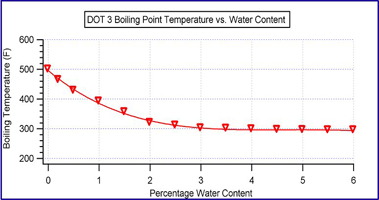 Another problem can occur when the thermal load from the pad heats the brake caliper piston to the point where the brake fluid behind the piston boils.
For standard DOT 3 fluid, this temperature is normally 260°C, but with even a small percentage of water absorption it can drop below 150°C (see figure).
When the water in the brake fluid boils it produces bubbles of steam. While fluids are incompressible, gasses are not. Having bubbles present in the brake fluid will result in a very soft brake pedal.
If the brake fluid gets significantly higher than the boiling point then the brakes fail entirely and the brake pedal will go to the floor.
Another problem can occur when the thermal load from the pad heats the brake caliper piston to the point where the brake fluid behind the piston boils.
For standard DOT 3 fluid, this temperature is normally 260°C, but with even a small percentage of water absorption it can drop below 150°C (see figure).
When the water in the brake fluid boils it produces bubbles of steam. While fluids are incompressible, gasses are not. Having bubbles present in the brake fluid will result in a very soft brake pedal.
If the brake fluid gets significantly higher than the boiling point then the brakes fail entirely and the brake pedal will go to the floor.
Both of these brake failure mechanisms are loosely referred to as "brake fade." Both failure mechanisms can be equally dangerous if they occur at the wrong time; like during a mountain descent.
CoolShims® Prevent Bus Caliper Failure in Testing at Greening Laboratories
Dynometer testing was performed on a Meritor Quadraulic brake caliper at Greening Laboratories Inc. Detroit, Michigan. The Meritor Quadraulic caliper is used on buses, fire-trucks, garbage trucks and other heavy vehicles employing hydraulic brakes. Testing included bringing the brake rotor to an operating temperature of 550°F before doing a series of stops from 60 mph to 10 mph at a deceleration rate of 15 ft/sec2 every thirty seconds. The standard caliper, without CoolShims®, experienced seal failure after only thirty-three stops. Installing CoolShims® prevented seal failure and decreased the brake fluid temperature 20%. The results agree well with on-vehicle testing (Other CoolShim Testing Performed).
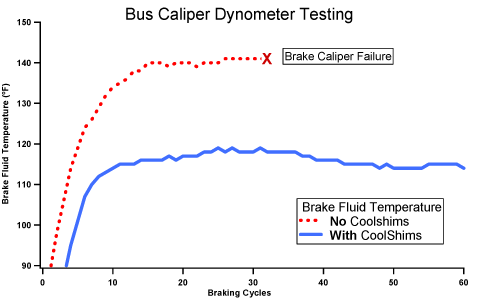
Other CoolShims® Testing Performed
The CoolShim testing procedures and results are discussed in an article published in the September 1st, 2005 issue of Nissan Sport Magazine (formerly Sport Z Magazine). However, since the magazine is out of print, a brief discussion is offered on this page while the complete article may be found here under its former name: Development of the Fade Stop Brake Cooler.
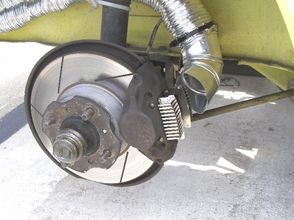 In order to monitor the temperature of the brake pad backing plate and caliper piston interface with and without the CoolShim, two custom thermocouple assemblies were manufactured that would fit onto the end of the caliper pistons of a 1970 Datsun 240Z.
These custom thermocouples are then connected to an Omega HH306 data logger. In order to establish CoolShim (cooled) versus stock (uncooled) temperatures, the thermocouples were installed on the driver's side and the passenger's side caliper pistons.
A pair of CoolShims® were only installed on one side during a given test drive. During the test drive, temperature data was recorded in one or two second intervals from both calipers. After completing the test drive, the Coolshim was moved to the other caliper and the test drive was repeated.
The data from the two test drives was then averaged to remove any difference due to variations from side to side.
These tests were performed with different brake pad compounds, but the highest temperatures were achieved while using Hawk HB Plus racing pads.
In order to monitor the temperature of the brake pad backing plate and caliper piston interface with and without the CoolShim, two custom thermocouple assemblies were manufactured that would fit onto the end of the caliper pistons of a 1970 Datsun 240Z.
These custom thermocouples are then connected to an Omega HH306 data logger. In order to establish CoolShim (cooled) versus stock (uncooled) temperatures, the thermocouples were installed on the driver's side and the passenger's side caliper pistons.
A pair of CoolShims® were only installed on one side during a given test drive. During the test drive, temperature data was recorded in one or two second intervals from both calipers. After completing the test drive, the Coolshim was moved to the other caliper and the test drive was repeated.
The data from the two test drives was then averaged to remove any difference due to variations from side to side.
These tests were performed with different brake pad compounds, but the highest temperatures were achieved while using Hawk HB Plus racing pads.
To the left is a picture of the front driver’s side brake caliper with a pair of CoolShims® installed (inside caliper and outside caliper units). Also shown in the photograph is one of the two cold air ducts that have been installed for this experiment: the one on the driver’s side is directed at the CoolShim while the one on the passenger’s side is directed at the brake caliper in roughly the same place. After installation of the CoolShim was completed, the car was taken for a test drive. It was not possible to tell that the CoolShim was installed; the brakes felt exactly the same.
The caliper piston temperature for both the caliper with the CoolShim and the caliper without the cooler were simultaneously recorded on the Omega HH306 at two second intervals during a descent from 3,500 to less than 1,000 feet along a mountain highway. Recording continued as the automobile was driven at highway speeds after the mountain descent. As stated previously the side with the CoolShim was switched and the test drive was repeated: variations in the thermocouple response, pad thickness, and possibly the airflow resulted in different results for the two sides. Therefore, the data from the two sides was averaged and the results are illustrated in the figure below with a best fit five term polynomial line.
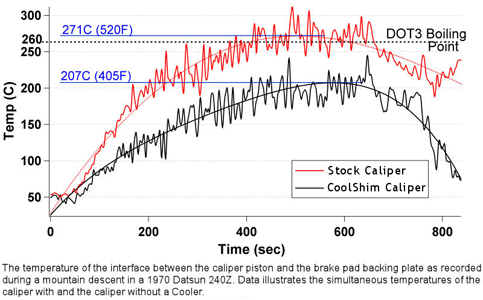
It is clear from the data that the caliper piston with the CoolShim installed stays an average of over twenty percent cooler. In this test, that twenty percent would have been the difference between boiling and not boiling "fresh" DOT3 brake fluid. Fortunately, I was running Super Blue brake fluid which has a slightly higher boiling point. Another interesting point to note from the graph is how much more quickly the caliper piston with the CoolShim cools down: it drops sixty percent in 200 seconds as compared to thirty percent for the uncooled caliper piston.
The CoolShim Brake Cooler clearly works!
One of the biggest issues with competition brake upgrades is the cost. Unlike competition rotors and calipers, however, the CoolShim is an extremely economical upgrade. CoolShims® should not wear out or need replacing except under extremely abrasive conditions.

